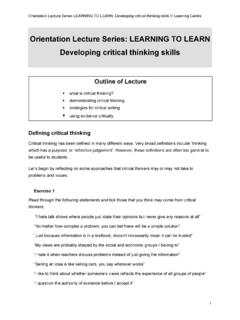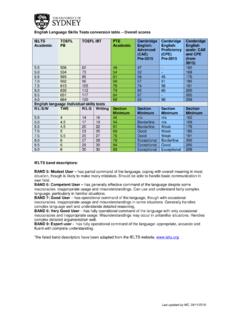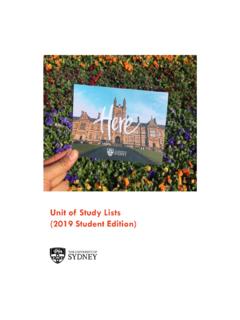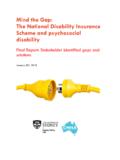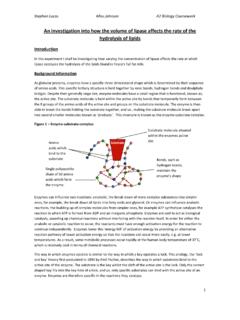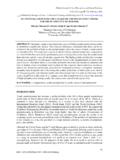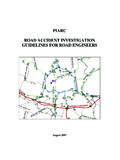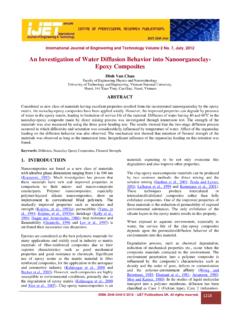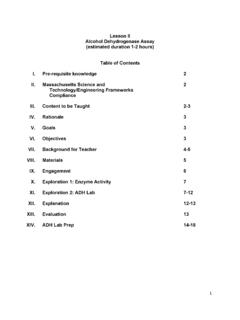Transcription of It’s your funeral An investigation of death care and …
1 S your funeralAn investigation of death care and the funeral industry in AustraliaProfessor Sandra van der Laan (University of Sydney Business School) and Associate Professor Lee Moerman (University of Wollongong)2017 The University of SydneyIt s your funeral : an investigation of death Care and the funeral industry in australia Professor Sandra van der Laan and Associate Professor Lee Moerman Contents Chapter 1: INTRODUCTION 3 Background 3 Objectives of the Research 3 Prior Research 4 Research Design 5 Structure of the Report 5 Chapter 2: SOCIO-CULTURAL FACTORS 6 Overview 6 Brief history of the funeral industry in australia 6 The funeral director in australia 7 death and demographics in australia 9 Transparency in the funeral industry in australia 10 Chapter Summary 12 Chapter 3: REGULATORY ENVIRONMENT 13 Overview 13 State Regulation of death and Disposal 13 industry Regulation 22 Regulation of Pre-need (Pre-Paid) Funerals 23 funeral Insurance 25 funeral Bonds 26 Chapter Summary 26 Chapter 4: DATA AND ANALYSIS 27 Overview 27 Method 27 Results 28 1 What Drives funeral Pricing?
2 30 Chapter Summary 36 Chapter 5: SUMMARY, CONCLUSIONS AND RECOMMENDATIONS 37 Summary and Conclusions 37 Recommendations 38 References: 39 Biographies: 41 List of Tables Table : Legislation/Regulations Governing the Transportation of Dead Bodies 15 Table : State Legislation/Regulations Governing the Disposal of Dead Bodies 16 Table : State Legislation/Regulations Governing Coffins/Caskets and Other Receptacles 21 Table : Particulars of a funeral Service in NSW 24 Table : funeral Services Online Contact 29 Table : funeral Services Direct Contact (whole $AUD) 29 Table : Number and Location of Observations 31 Table : One-way ANOVA 33 Table : Robust Regression 34 Table : Three-way ANOVA NSW funeral Prices and Indicator Variables 34 Table : Regression Analysis 35 List of Figures Figure : Percentage of Enterprises in australia in 2016 9 Figure : Price Segmentation of Funerals in australia 11 Figure : funeral Prices by State (excluding Territories) 31 Figure : NSW funeral Prices and Indicator Variables 33 2 This project was partly funded by a CPA australia Global Research Perspectives Program.
3 The researchers independently determined the research designed and analysis associated with this project. This funding had no influence on the findings or recommendations arising from this research. The authors would like to thank Jo Walker for her research assistance and Tina Huynh for her help with the data and analysis. Contacts Professor Sandra van der Laan +61 2 9351 6431 Associate Professor Lee Moerman +61 2 4221 5575 3 Chapter 1: INTRODUCTION Background Benjamin Franklin s famous quote in this world nothing can be said to be certain but death and taxes! (Franklin, 1817, p. 266) reinforces the inevitably of death . As a consequence, death -care will touch everyone at some stage. This connection can be through funeral arrangements for a relative or friend; planning one s own send-off through pre-need (pre-paid) funerals or bonds; or organising memorials. death -care involves at least four distinct aspects or services.
4 First, is disposal of the body, most commonly through burial or cremation1. This aspect is the only mandatory requirement for dealing with the deceased (see Chapter 3). Second, is the ceremonial aspect - the funeral service or the send-off . Third, the memorialisation aspect including new age virtual memorials or a headstone or plaque providing a sense of place for the deceased. Finally, planning for funeral needs through various means including bonds, insurance and pre-need arrangements. In the funeral industry , financial value is largely created through the non-essential bundling of the first two or three aspects, mergers and acquisitions to exploit economies of scale, vertical integration of death -care services as well as the selling of pre-need funeral packages. On one hand, while the key revenue driver the number of deaths in australia is rising, the death rate (number per thousand population) is falling (IBISW orld, 2016) and the industry may need to find innovative ways to value-add in the future.
5 Since the provision of death -care is considered to be recession-proof, the risk to revenue streams comes mainly from competition for goods and services in an increasingly corporatised sector. And, in an Uber-style environment of disruptive technologies providing innovative solutions, this competition may come in forms never dreamt of or imagined a decade ago. Since funeral practices are culturally grounded there is an Australian way of death that has, in turn, influenced the development of the death -care industry locally. Jalland (2006) asserts that two major factors, demography and religion, influenced death and bereavement in the 20th century. Demography, in terms of a shift from high infant mortality to death from old age; and, the influence from an influx of Catholic and Orthodox immigrants from southern Europe in the 1950s. These factors contributed to a gradual trend of distancing death from the living and the development of an industry of family and community owned funeral homes.
6 By the 1970s, the entry of operators into the Australian market was the beginning of a change as local subsidiaries exploited regulatory gaps and weaknesses and eventually monopolised the death -care value chain on the profitable east coast of australia (IBISW orld, 2016; Larkins, 2007). According to IBISW orld (2016) the funeral Directors, Crematoria and Cemeteries industry is a billion dollar industry in australia with an expected 10% growth within the next five years. Currently InvoCare Limited2 (InvoCare) a multinational corporation holds a 40% market share of this lucrative business while the remaining 60% is fragmented with small and family owned enterprises3. Objectives of the Research As noted earlier, the death -care encompasses at least four aspects, however for this report our primary focus is on the costs, pricing and transparency aspects of ceremony and disposal that is 1 In recent years a technique known as alkaline hydrolysis or flameless cremation has been developed as another method of disposal (Olson, 2016, ) 2 InvoCare Limited was floated on the ASX (IVC) in 2003 and is the largest operator in the Asia-Pacific Region.
7 3 For example, Tobin Brothers Pty Ltd is a family owned and run business with 23 enterprises in Victoria and enjoys a mere market share (IBISW orld, 2016). 4 generally undertaken by funeral directors4. Disposal of the deceased in a dignified manner is regarded as an essential service in australia and therefore should be available to all, regardless of income (CPSA, 2009). Therefore, the aim of this research is to develop a comprehensive understanding of the funeral industry in australia and the drivers of costs and prices in the current regulatory environment. Given the recent corporatisation and increasing concentration of the industry (Cottle & Keys, 2004; IBISW orld, 2016), the study is designed to report on the following: the size and structure of the funeral industry in australia , the social, cultural, regulatory frameworks and institutional impacts on the industry , the cost and price drivers in the industry , the price of a direct committal (cremation) and a basic or essential services funeral in australia in 2016 provided by funeral directors, and, the scope and regulation other products that exist in the funeral industry ( funeral insurance and funeral bonds).
8 Disclosures regarding pricing and costs of the various options for funerals and body disposal will enable consumers of these services to make more informed choices and address the concerns of predatory marketing and price gouging in the industry (see van der Laan and Moerman, 2014). And, while both independent funeral brokers (see ) and InvoCare planning websites (see ) offer opportunities for consumers to compare packages among funeral directors, this report will provide recommendations for policy makers and regulators in terms of promoting consumer choice, protecting vulnerable consumers by contributing to efforts to increase price transparency. Prior Research The funeral industry has attracted the attention of the popular press and governments ( CPSA, 1992; FCDC, 2005; NSW Parliament, 2005: Shelley, 2011) due to the social impact of its services and its size. Additionally, death -care in general and the funeral industry in particular is largely ignored as a research site in the accounting literature.
9 The market in which funeral directors operate is non-traditional and it is not surprising that complaints about pricing, over-servicing and consumer exploitation have arisen. funeral pricing came to the attention of various governments in the 1970s following suggestions that consumers of funeral services were being exploited at their most vulnerable (Larkins, 2007). Around the same time, there was an expansion in the services offered by funeral directors to combat cut-price competition by offering simple or no-frills funerals (Jalland, 2006). In response to consumer complaints about overpricing and transparency by funeral directors, the Pricing Surveillance Authority (PSA) conducted an investigation into funeral Prices in 1991. It concluded that consumers need to be educated about funeral operations to prevent potential exploitation from the information and power asymmetry in the industry (PSA, 1992).
10 Further inquiries into the industry were conducted by the NSW and the Victorian governments in 2005 focussing on pricing practices, industry conduct and transparency. Several recommendations were implemented including regulations regarding the disclosure of costs and the requirement for the service providers to offer a basic or essential services funeral to enable consumer comparison across providers. The NSW Fair Trading Act 1987 defines a basic funeral as: The supply of specified goods and services, including the arrangement and conduct of a funeral service to be held during ordinary business hours, limited transport of a body, and supply of the least expensive coffin that a supplier of a funeral goods and services has available (NSW Fair Trading, Explanatory Note, 2008). 4 Recently, web-based enterprises offering direct committal services through the internet have emerged.
